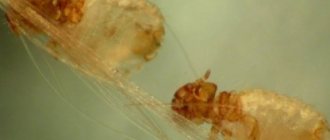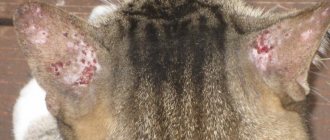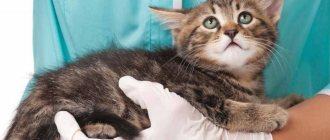Sometimes worms in cats are quite difficult to notice until the colony reaches such a size that individual individuals begin to appear in the feces. Symptoms of helminthiasis (infection with helminths) can often masquerade as other diseases. It is important to immediately pay attention to your pet’s unusual behavior and show it to the veterinarian.
The most common symptoms of infection are loss or sudden increase in appetite, irritability, and diarrhea. If you notice any of these signs, inspect your cat's litter box. If there are white specks in the stool that look like rice, these are parasites. It is not difficult to cope with this problem if you start treatment on time.
Possible causes and routes of infection
Even a pet that has never been outside can become infected with worms, or helminths. This is due to the vitality of parasites and their ability to move on all kinds of carriers. Therefore, even domestic cats need to be given anti-worm medicine at least once every six months - this will guarantee the pet’s health.
How does infection occur?
Parasite eggs are constantly in the environment. An animal only needs to swallow a few larvae to become a carrier. Sometimes infection occurs when the parasite is inhaled or gets into a wound on the skin: a cat only needs to rub or smell something to catch helminthiasis.
Sometimes the infection enters the body through insect bites - fleas or mosquitoes. The risk increases significantly in the summer.
The larva, once in a favorable environment (that is, in the body of a mammal), begins to develop and later reproduce. This process does not take too much time, so helminthiases in cats quickly become noticeable.
Severe infection is fraught with the addition of secondary infections, general weakening of the body, and in advanced cases, death.
Where can helminths live?
Worms in cats, like in other mammals, usually establish a colony in a part of the body familiar to their species. These are the intestines, liver, lungs or heart, kidneys, less often – stomach, eyes or bladder.
The larvae enter the environment along with the waste products of the animal: urine, feces, saliva, sputum. Sometimes worms can travel on hairs of fur, remaining on grass, soil, or human clothing.
Each type of worm in cats has its own incubation period, and it is quite long. The larvae survive in different humidity and temperature conditions, and sometimes they tolerate chemical treatment. Therefore, it is important to regularly worm your pet and monitor its health.
Risk factors
The most common variants of infection:
- the cat regularly goes outside, where he sniffs the marks of his street brothers or eats contaminated food;
- the cat lives at home, but is treated to unwashed grass from the street - there could also be particles of urine or feces of infected animals on it;
- a sufficient number of parasites live in raw meat or fish, so they must be thermally processed;
- a person can bring helminth eggs into the house on clothes or shoes;
- the animal had sexual contact with an infected partner - before mating, the male and female must be wormed to avoid such a nuisance;
- the parasite enters the pet’s body through insect bites - fleas, ticks, mosquitoes;
- kittens become infected from their mother in the womb or through direct contact.
If a cat has a strong immune system, he is unlikely to become infected, even if he communicates with his street brothers. And weakened animals (kittens up to six months, older individuals, chronic cats) have a risk of getting sick even through indirect contact with an infected object, not to mention living carriers.
Rules for taking medications for worms
Before choosing a deworming drug for your pet, it is necessary to find out by taking tests from a veterinarian what kind of worms the animal is infected with. The veterinarian will prescribe a specific medication and treatment regimen.
As a preventive measure, animals can be given complex-action drugs once a quarter. Pets are also given worming 7-10 days before vaccination!
Before you administer the medicine yourself, you must read the instructions for the medicine. You should not use several different anthelmintic drugs at the same time - the active ingredients may be incompatible with each other!
The danger of helminthiasis
The initial stage of the disease does not harm the animal - except that it loses a little weight. But parasitosis does not go away on its own, and if treatment is not started, everything will progress to an advanced stage, which can lead to complications.
For the animal
Worms in cats can cause irreparable harm to the body and even cause death. What disorders occur in the body of an infected pet:
- worms gnaw passages in internal organs, causing damage and hidden bleeding;
- waste products of parasites poison the animal, it begins to vomit, diarrhea, and refuses to eat;
- the pet’s immunity drops and it becomes vulnerable to infections and viruses;
- severe infection is fraught with blockage and obstruction of the intestines, and if the localization of the worms is in the heart or blood vessels, then there is a high probability of damage to vital arteries.
The latter options are extremely dangerous, as they can be fatal. Advanced cases should be treated only under the supervision of a veterinarian.
For man
A person runs the risk of becoming infected from the animal with whom he lives. It is enough to pet your pet and not wash your hands for the probability of transmitting the parasite to be 90%. Therefore, when worms are detected in cats, not only four-legged friends, but also all family members, especially children, undergo deworming.
Prevention of helminthic infestations
It's no secret that any disease (including feline helminthiasis) is easier to prevent than to treat. In addition, it should be remembered that the helminths that infect cats can easily infect humans. To do this, it is not at all necessary to kiss the purr: there are worm larvae on the fur of sick animals. So you need to protect your cat from a dangerous disease, including for your own safety.
To prevent helminthic infestations in cats it is necessary:
- keep the house clean: regularly wash the floor at the front door, clean door mats, put shoes out of reach of the cat;
- wash your hands before cuddling your cat after returning home from the street;
- do not feed your cat raw meat or fish; it is also better to give boiled or filtered water;
- keep your pet's toilet clean: excrement must be removed immediately, and not only change the filler, but also wash the tray itself;
- If possible, do not let the cat go outside;
- install mosquito nets on the windows to prevent flies and mosquitoes from entering the apartment;
- every three months to prevent infection, use anti-parasite products (not only worms, but also fleas and ticks).
Following these simple rules will reduce to a minimum the likelihood of a cat (and therefore its owners) becoming infected with worms.
Types of cat helminths
All types of worms in cats are divided into three large groups: round, flat and tape. They differ from each other in their distribution methods and habitats. The specifics of symptoms and treatment of worms in a cat directly depend on the type of parasite.
Roundworms (nematodes)
The most common types of nematodes in cats are :
- Toxocara, or roundworm, is the most common species found in the cat's body. They grow from 3 to 10 cm in length and live exclusively in the small intestine. Their eggs leave the body along with feces, end up in the soil, water, and can sometimes be contained in dust. Often, a pet becomes infected with nematodes by eating raw meat. Once in the intestine, the eggs pass through its walls and penetrate into the blood, and then spread throughout the animal’s body. After some time, they reach the lungs, where they rapidly develop, causing discomfort to the animal and causing coughing. Along with sputum, some of the mature eggs enter the stomach, and then again into the intestines, where adult worms lay eggs again.
- Hookworms enter the body through the skin, reach a length of no more than 2 mm, multiply and parasitize in the intestines.
- Heartworms, or heartworms. They enter the body through the bites of infected mosquitoes or fleas. Penetrating into the blood, they reach the heart, muscles, lungs, or settle in blood vessels, where they multiply.
People can also become infected with nematodes if they do not wash their hands after contact with an infected animal or after cleaning its tray.
Tapeworms (cestodes)
Tapeworms live exclusively in the intestines. Using small sharp hooks located in the front of the body, the worms cling to the walls of the colon. Cestodes are found in low-quality raw meat. There are several cestodes that are potentially dangerous for cats and kittens:
- Cucumber tapeworm. This parasite grows in the animal's body from 10 to 70 centimeters. The body of the worm consists of a head, with which it clings to the intestinal wall, and segments that contain eggs. As soon as they mature, the segments break off and are passed out in the feces. The eggs enter the bodies of insects. If a cat eats an infected fly or a flea with parasites living in its body gets on its body, the pet will become infected.
- Wide tape. It is similar to the previous species, but its eggs develop mainly in river fish and crustaceans. In this case, after eating raw fish or swimming in a river, your pet can catch the infection.
- Echinococci and alveococci. Their temporary carriers are rabbits and rodents. They grow up to 4 mm in length. This type of worm is the most dangerous because while the adult representatives live in the intestines, their larvae spread throughout the body, settling in the brain, eyes, heart, liver and other organs.
Cestodes are not dangerous for people in contact with a pet. However, like animals, humans can become infected with worms through the meat of intermediate carriers (fish, beef, crustaceans, etc.).
Trematodes (flukes)
The rarest type of parasite found, but also the most dangerous. Flukes feed on animal tissues, destroying and damaging them. What types of these worms are found in cats:
- Cat fluke. Its scientific name is opisthorchus. This parasite grows from 5 to 150 millimeters and mainly affects the liver and gall bladder. They have a complex life cycle, which includes as many as two intermediate carriers. First these are snails, crustaceans and other small river creatures, then fish. Thermally untreated fish can cause infection in your pet.
- The pulmonary fluke spreads in a similar way, but its habitat is the lungs of the animal.
Due to their complex development cycle, trematodes are not dangerous to humans. Infection from both the pet and the carrier fish is excluded.
Why are worms dangerous for cats?
A cat's health is at risk when there are high numbers of worms in the body. As we have already understood, the symptoms when cats are infected with worms are very non-specific. They can also be confused with bacterial, viral and non-communicable diseases. Regular prevention is important to prevent critical disorders.
• Can a cat, cat or kitten die from worms?
Worms in cats and kittens can cause death if the infestation is severe, but, as a rule, owners manage to notice the symptoms and cure the animal.
Symptoms of helminth infection
Despite the fact that each type of parasite is characterized by special symptoms, there are several common signs of worms in a cat:
- changes in the animal’s behavior – usually nervousness, lethargy, a desire to take cover and sleep longer;
- loss of appetite or complete refusal to eat - in case of infection with lungworms or heartworms;
- increased appetite due to intestinal parasites;
- hair loss, dullness, tuftiness;
- abdominal enlargement;
- problems with the digestive system: diarrhea, constipation and their alternation, rapid weight loss, causeless vomiting.
Owners of healthy animals with good immunity often do not notice the appearance of parasites due to the fact that there may be no symptoms at all. They appear only at an advanced stage.
If helminths have settled in the intestines or stomach, they can be identified by bloody impurities in the cat’s feces, bloating or diarrhea. Check your cat for the following symptoms: pale mucous membranes, itching and irritation in the area under the tail, vomiting and thirst.
Heart parasites are characterized by general exhaustion, vomiting and severe coughing, shortness of breath, and an increase in the animal’s body temperature. The cat does not play, eats little and breathes whistlingly.
If worms in cats have settled in the liver, the pet vomits yellow and is bothered by pain in the right side. The doctor may also detect liver enlargement and nodularity.
Due to parasites in the lungs, the cat will often cough and even spit out blood. In addition, chest wheezing and fever are distinctive symptoms.
Symptoms are more pronounced in older individuals or in animals with weakened immune systems. If worms are found in a kitten, it will not be surprising that he lags behind his brothers in mental and physical development. He develops other health problems if treatment is not prescribed on time. In extremely advanced cases, the baby may die.
Prevention of worms in cats
Prevention of infection with worms in cats is perhaps the most important means of helping to preserve the health of the pet and its owner.
To do this, it is necessary to prevent healthy animals from coming into contact with untreated ones, feed them with ready-made or heat-treated food, keep shoes and outdoor clothes in a closet to which the cat does not have access, and keep the litter box clean.
Particular attention is paid to preventive treatment schemes using veterinary anthelmintic drugs:
- For cats that do not go outside and do not have contact with other animals, treatment is recommended 2 times a year, or testing feces for worm eggs.
- For cats that periodically walk outside under the control of the owner and communicate with other treated animals, prophylaxis is carried out 3 times a year.
- Cats that hunt mice, often walk outside, or interact closely with untreated animals are recommended to be treated 4 or more times a year.
Diagnosis of infection
At home, it is not so easy to determine the presence of worms in a cat or kitten. Pay more attention to the general condition of your pet and any deviations in behavior. Check your pet's stool from time to time for worms and eggs.
There are many more ways to identify parasites in a veterinary clinic. There, your pet can have an ultrasound, x-ray, and tests:
- General stool analysis. This procedure is necessary to detect eggs in feces. This method is not always effective, since newly emerged worms may not have had time to lay eggs. If the result is negative, it is recommended to repeat the test after some time.
- A chest x-ray and sputum analysis are needed to identify parasites in your pet's lungs.
- Ultrasound (ultrasound) helps look for signs of infection in the heart, liver and other internal organs.
The appearance of pests in the body is accompanied by an increase in the number of leukocytes in the blood. Therefore, before conducting research, the cat's blood is taken for analysis.
Often the appearance of cat worms can be confused with other diseases, such as a cold, infection or stomach upset. Therefore, only a specialist can tell exactly what your pet is sick with.
Anthelmintics
There are many modern effective anthelmintic drugs. They differ in their spectrum of action: some drugs kill only one type of parasite, while most act in a complex manner.
Based on the form of use, anti-worm medications are divided into several groups, and here you will have to experimentally find out which option is best for your pet.
Most often you can buy tablets in pet stores, such as:
- Drontal, cestal - acts on round and tapeworms, one tablet is given per 4 kg of animal weight;
- Milbemax/Milprazone is a complex-action drug that is destructive to both adult worms and their larvae; effective not only against worms that have settled in the intestines, but also in blood vessels and the heart;
- Dirofen - has a pronounced complex effect, but is especially effective against nematodes and tapeworms; It is also available in the form of a suspension and paste.
When giving medicine, under no circumstances should you frighten the animal, squeeze it, or hold it forcibly. Gentle stroking of the withers and neck will calm the pet, and then you can gently open its mouth and quickly place a pre-prepared tablet on the root of the tongue. After this, you need to close your mouth and, trying to hold her head up, lightly stroke her neck, encouraging her to make a swallowing movement.
If your pet stubbornly spits out the tablet, you can crush the drug and either mix it with your favorite cat treat, or dilute it with water and carefully inject it into the mouth from a syringe (without a needle!).
Suspensions
Suspensions are more convenient for use. Included with the medicine is an atraumatic syringe, with which it is not only easy to measure the required amount of the medicine, but also to quickly give the medicine to the cat. The main thing is to also try to get it on the root of the tongue so that the pet swallows the suspension.
The most common suspensions are Prasitel, Prazicide and Dirofen. Prazitel has a complex effect, killing parasites at any stage of development. Another advantage of this suspension is the absence of any taste.
Drops on the withers
Another type of anthelmintic drugs is drops on the withers: Stroghold. The medicine according to the dosage is applied to the withers of the animal, after a few days the procedure is repeated.
Treatment for parasites
As soon as there is a suspicion of infection, any owner will think about what they give cats for worms? You cannot choose medications on your own, as they may turn out to be ineffective and even unsafe. If a cat has worms, what should the owner do? There is only one answer - contact a veterinarian, who will prescribe the appropriate medicine and calculate the dosage.
There are two types of deworming medications for cats: for oral use and for external use. External products are presented in the form of a variety of drops and sprays. The second group is a variety of tablets, pastes, suspensions, etc. If the case is advanced, treatment is carried out using injections. Therapy always depends on the type of worms in the cat.
Preparations for oral administration
All drugs are divided into single-component drugs aimed at eliminating a specific type of parasite, and broad-spectrum drugs against many types of helminths.
The principle of action of the medicine is quite simple. When it enters the parasite’s body, it first paralyzes it, then the nervous system is damaged, which kills the worm, and in the end the outer shell is literally “burned”, and its remains are released along with the feces of the mammal.
It is permissible to independently remove worms from a cat if you were able to correctly identify their type. In this case, only complex preparations are allowed to be used. Only a doctor can prescribe more precise treatment with single-component drugs - he will also write a prescription for them.
If for prevention the animal is given only one dose of medication, then therapy involves taking the drug twice with a break of 12-14 days. Before taking, be sure to read the instructions for use and check the dosage.
Most often, owners use drugs such as “Fenasal”, “Drontal”, “Polivercan” and “Prasicide”. These medications should not be given to pregnant pets or kittens less than 3 weeks old.
If the dosage is incorrectly selected or intolerance to the components, complications may occur. Sometimes, due to an excessive amount of decomposing remains of parasites in the body, the pet begins to become intoxicated. If an animal has diarrhea or vomiting after deworming, it should be given activated carbon, Polysorb or other absorbents. Grind the tablet, mix with water and use a syringe without a needle to pour into the cat’s mouth. Vomiting or diarrhea should stop within 3 hours. If this does not happen, contact your veterinarian immediately.
Preparations for external use
Without a doubt, topical medications have their advantages and disadvantages. Many veterinarians advise using external remedies along with internal ones. This helps destroy worm eggs that enter the animal's body through the skin. These medications usually contain insecticides. Using the drops is very simple, you just need to apply the product on the cat's back in places where he cannot lick them off. If everything is done correctly, deworming will be safe.
Do not forget about the shortcomings of the product. Chief among them, perhaps, is the weakness of action. They are used mainly as a preventive measure or in the early stages of infection. Cats often develop an allergy to the active substance or skin irritation, so be careful during use.
Injections
Injection therapy is highly undesirable at home. Even a small mistake in dosage can kill a cat. Therefore, under no circumstances use anthelmintics by injection without a doctor’s prescription.
The dosage is calculated based on the calculation of 0.01 ml per kilogram of weight, but there may be a different ratio - it all depends on the specific drug, the age of the animal and the severity of the disease. An ampoule of 1 ml is enough to treat 30 average cats weighing 3-4 kg. The concentration of the drug is reduced using a special solution sold in pharmacies. Usually the medicine is injected into the femoral muscle; if necessary, the procedure is repeated after 10-14 days. Injections are used only as a treatment in the later stages of infection, and they are not used as vaccinations.
Traditional methods
Veterinarians are skeptical about a variety of folk remedies and herbs. Their use is recommended only if you do not have the opportunity to buy conventional, more effective medications. Treatment of worms in cats with herbs should in any case be carried out under the supervision of a veterinarian.
It is difficult to say whether traditional methods will help the animal. Often, after using them, cats experience poisoning or develop allergies, causing even more problems for both the pet and the owner. The harm from self-medication is obvious, so all folk remedies should be given to the cat only after consultation with a veterinarian - he will tell you the dosage and timing of therapy.
How to remove helminths from a pregnant cat and kittens
Owners are often concerned about what can be given to pregnant cats against worms so as not to harm the mother and offspring. In order to avoid unpleasant situations, a month before mating, prophylaxis is carried out for both partners. However, if this was not done in a timely manner or the pet caught the infection during pregnancy, it is strictly prohibited to treat it on your own.
Contact your doctor to see if intervention is necessary at this time. Perhaps he will prescribe special medications that can be given to pregnant women. Treatment will depend on the stage of pregnancy and the degree of infection.
Treatment of worms in kittens is carried out only after reaching two months of age. It is impossible to start therapy earlier. All that can be done is to treat the mother, and the babies will receive a small dose of anthelmintic with her milk.
How to give medicine to a cat
If the medicine is used in the form of a paste, then a special syringe is included with it. With its help, the medicine is administered to the animal through the cheek. The drops should be applied to the withers, while isolating the cat from other pets. Giving a cat a pill is a little more complicated.
There are several ways:
- Place the tablet in the cat's mouth, forcefully close his mouth (do not overdo it, the animal should not be hurt) and begin stroking his throat intensively. Such movements will trigger the swallowing reflex. To prevent the cat from twisting and sticking out, place her on your lap with her back to you. Trying to free herself, she will rest against your stomach.
- Crush the tablet and mix with 1-2 tbsp. l. water. Draw the resulting mixture into a syringe and pour the medicine into the cat’s cheek, lifting its muzzle up. Make sure that the medicine does not leak out and that the animal does not spit it out. Important, remove the needle from the syringe!
- Mix the medicine, crushed to a powder, with the food. It is advisable to use industrial canned food, minced meat or baby food.
Be sure to read the instructions for the drug before giving it to your pet.











